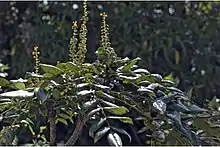Mahonia leschenaultii
Mahonia leschenaultii is a plant that belongs to the genus Mahonia. It is indigenous to the temperate and subtropical regions of the Indian sub-continent: Nepal, the Himalayas, Himachal Pradesh, Khasi Hills and the Nilgiri Mountains. In the Nilgiris, it is of religious and medicinal importance to the native Toda people, who call it Thovari.[1]
| Mahonia leschenaultii | |
|---|---|
 | |
| Scientific classification | |
| Kingdom: | Plantae |
| Clade: | Tracheophytes |
| Clade: | Angiosperms |
| Clade: | Eudicots |
| Order: | Ranunculales |
| Family: | Berberidaceae |
| Genus: | Mahonia |
| Species: | M. leschenaultii |
| Binomial name | |
| Mahonia leschenaultii (Wall. ex. Wight & Arn.) Anon. | |
Description
Mahonia leschenaultii is a shrub (although occasionally it may grow into a tree) reaching no more than 6 metres (20 ft) high. Leaves are oblong and have glossy tops; they are positioned botanically opposite. Yellow petaled flowers are borne in two seasons: April through June, and September through November. Small 8 mm (0.31 in), one-seeded berries are borne about a month after flowering.[1]
Uses
The Toda people of Tamil Nadu use a paste made of the bark as a Traditional medicine remedy for women immediately after childbirth. The Toda also use a water extracted from the leaves to purify their temples after women have entered them, as women are forbidden from Toda temples.[1]
References
- Rajan, Sheelu; Sethuraman, M (1992-07-01). "Mahonia leschenaultii—A Toda plant". Ancient Science of Life. 12 (1–2): 242–4. PMC 3336628. PMID 22556593.